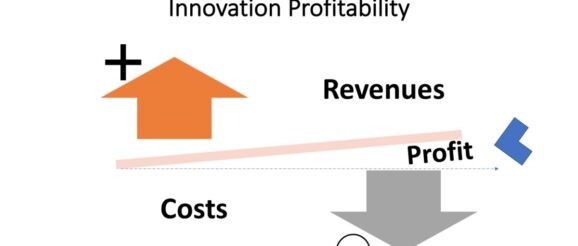How do you plan innovation profitability, and what are the key influences?

Innovation must pass three tests before it becomes successful; the first is the desirability, the second is the feasibility, and the third is the viability test. The desirability test proves the creation of sufficient demand for innovative products, whilst the feasibility test shows the ability of the innovation project to make the value proposition around the innovative products acceptable to customers. In turn, the viability test proves the profitability of the innovation project. In this article, I will highlight the definition of innovation profitability and its influences affecting profitability.
What and how do you plan profitability?
Innovation profitability tests the viability of business models and shows revenue surpluses over expenses and healthy cash flows. By this, profit is net revenues after subtracting all expenses for the period (e.g., one year). Revenues are incomes a company makes from especially sales, and expenses are expenditures (e.g., salaries) and non-expenditures (e.g., depreciation and provisions) a company bears to get certain services associated with revenues for the period (e.g., one year). While cost structures comprise the company fixed and variable expenses. The firm production levels do not affect fixed expenses, such as depreciation or administration expenses; contrarily, variable costs are expenses like the cost of raw materials and production labour, which are associated with the production levels. Innovation profitability is a positive sign of successful decisions and projects resulting from higher demand over expenses.

You can study the profitability of your project by conducting a viability analysis, which comprises cash flow projections over the term of the project, and estimated net present value NPV, internal rate of return, and payback period. Accordingly, the project is viable if its NPV is relatively positive, the IRR is higher than the return on similar risk projects, and payback is attractive (e.g., depending on the nature of the project; less than 15 years). As an innovator, you need to plan profitability and test viability before you implement the innovation project, and to do so, you will need to:
- Plan revenues (expected sales a year for 3-5 years)
- Plan expenses (expected expenses a year for 3-5 years)
- Plan the breakeven point (estimate the breakeven point and schedule to achieve it).
- Ensure profitability ahead of time.
What are the key influences of innovation profitability?
Here are some influences that affect innovation profitability:
- Leadership: is the way the company is managed, and this has a positive correlation with the expected profitability. Leadership in any business reveals how top management draws strategies, obtains sufficient resources, leads teams, and transforms a growing and profitable business.
- Pricing strategy: there are many methods to price products or services, including cost-plus, skimming, penetrating, premium, low-price, or competitive pricing. Yet, any pricing strategy applied must contribute to the business’s profitability. Pricing is strongly correlated to two aspects: revenue streams and profitability. If the pricing method applied enables the firm to overpass the breakeven point and achieve economy of scale, then this strategy is a profit enabler.
- Revenue streams: are mainly sales, and the more a firm makes sales the bigger the chance of profitability. Revenue streams are the key to innovation profitability and are influenced by many factors like value proposition, competition, pricing strategy, sales and marketing strategy, investments and more.
- Cost structure: shows the fixed and variable costs a company bears in, for instance, one year. Costs are obligations companies carry to obtain services, and the more the cost structure is inflated, the little chance a business becomes profitable. Importantly, most technology companies bear higher fixed costs, especially during the first years, making profitability significantly hurdle to reach. Tips to reduce fixed costs and improve profitability include leasing assets instead of buying them, partnership, reducing permanent staff, financing equity instead of loans, and more.
- The breakeven point: is a financial analysis tool that measures the sales point (quantity or value) where revenues and costs are equal, and thus profit is zero. The earlier a company reaches the breakeven point is better, and any sales afterwards the breakeven point will turn out to be profitable. The breakeven point can be calculated by the formula- yearly fixed cost divided by the contribution margin or value.
- Efficiency and productivity: efficiency shows the productivity of resources, whilst productivity is measured as the number of products produced by a head over a year. Efficiency and productivity both positively contribute to the profitability of the firm.
- Resources: are human, capital, assets, and non-physical assets like brands, copyrights, and know-how. Resources are a must-have in the firm to make a profit, but they depend on the quality of leadership, efficiency and productivity. Motivated staff, for instance, positively contribute to the company’s profitability.
- Technology: comprises software and hardware, and it is an asset enabling the company to stand from the crowd, increase efficiency, improve quality, reduce the lead-time to the market, reduce the cost, and reach economy of scale. What is more important for profitability is the application of technologies.
- Discount rate: is the return rate investors accept annually on their investments similar to associated risks to the innovation project. When the discount rate increases, the interest expenses on loans will also increase, causing the company to suffer in increasing profitability. Another issue is if the discount rate applied for the financial analysis is inflated due to higher risk or others, this will negatively influence the project viability, including the NPV, IRR, and payback period.
- This post is sourced from my new book- Your Guide To Reach Innovation.
Final note: the book- Your Guide To Reach Innovation, is an actionable guide to innovation from beginning to end. Enjoy reading the book, and I look forward to your reviews.
Author: Munther Al Dawood
